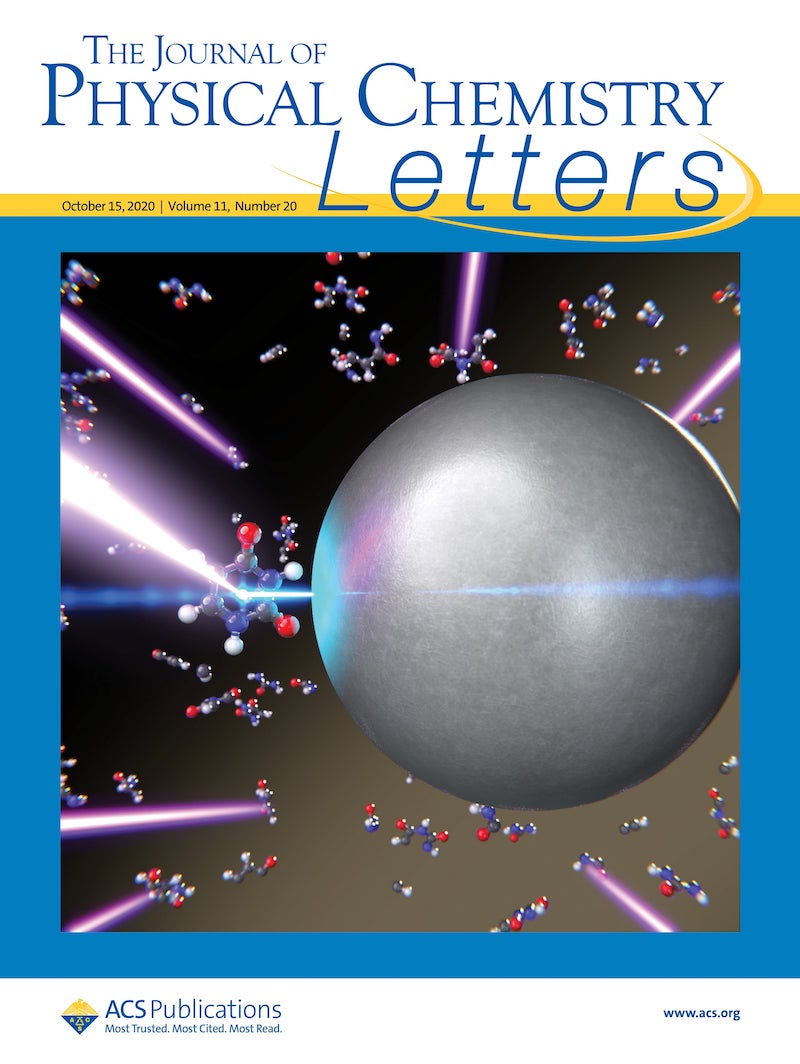J. Phys. Chem. Lett. on Photoprotecting Uracil by Coupling with Lossy Nanocavities

- JPCL Supplementary Cover illustrating the paper: A uracil molecule excited by UV light (violet) can be protected from photodamage by opening an ultrafast dissipation channel to a lossy nanoplasmonic mode (blue).
Our work “Photoprotecting Uracil by Coupling with Lossy Nanocavities” has just been published in The Journal of Physical Chemistry Letters. The work was conducted in collaboration with the group of Regina de Vivie-Riedle (Ludwig-Maximilians Universität München) and has been highlighted with a Supplementary Cover created by Enrique Sahagún / Scixel.
In a nutshell, we show that cavity-induced dissipative effects can have an important role in modifying chemical reactions, and propose a new method to enhance the photoprotection mechanism of DNA-like structures using simple metal nanoparticles.
If you want to know more, let us provide some context and summarize our main findings:
Coupling quantum emitters with localized modes of light (electromagnetic fields) represents an extremely promising scientific and technological endeavour. Using photonic structures to confine the electromagnetic field makes it possible to modify and even induce new optical, electrical and chemical properties of materials. In this context, significant experimental effort is dedicated to the enhancement of the ratio between the strength of the light-matter interaction and the dissipation rates. The larger this ratio, the larger the modifications to the system properties are commonly expected to be. Indeed, when the coupling overcomes the losses, the system enters the strong coupling regime, where light and matter come together to generate hybrid excitations called polaritons. However, as we show in the paper, depending on the desired functionality, it can instead be advantageous to use very lossy modes.
Polaritonic chemistry describes the collection of techniques used to modify molecular properties by strong coupling to confined light modes. In this framework, the quantized electromagnetic field can be considered on the same footing as a chemical reactant: with the aid of polaritonic states, it is possible to catalyze photochemical reactions, to modify the relaxation pathways of molecules, and to mediate energy transport phenomena. Plasmonic nanocavities, i.e., metallic structures in which the collective electron motion leads to strong sub-wavelength confinement of light, are particularly promising in this context as they can reach single-molecule strong coupling at room temperature. While such systems hold the promise to control chemistry on the single-molecule level, many applications are limited by their strongly dissipative nature. Indeed, the typical lifetime of plasmonic nanocavities is of the order of ten femtoseconds. So far, the role of photon losses in polaritonic chemistry is poorly understood, and only some state-of-the-art theoretical models have started to include dissipative effects.
In our work, we theoretically analyze the photorelaxation dynamics of a single Uracil molecule coupled to a dissipative light mode in a plasmonic nanoparticle. We focus on the role of photon decay using a chemically and physically accurate description of the molecule and nanoparticle. By coupling uracil molecules with localized electromagnetic modes, we open an additional relaxation pathway which is up to twice as efficient as the natural photoprotection mechanism. Counterintuitively, we find that there exists an optimal trade-off between light-matter coupling and photon decay which maximizes the efficiency of the additional photorelaxation channel at quite high loss rates.
Our results have both fundamental and practical consequences. On the one hand, we theoretically demonstrate that better cavities do not necessarily correspond to improved photochemistry. On the other hand, we provide a way to speed-up the photorelaxation of DNA-like structures using simple nanoparticles, without requiring the development of complex nanophotonic structures. Our study paves the way to the use of lossy photonic devices as a tool to tailor photorelaxation channels and to selectively inhibit reaction pathways.
 MMUSCLES
MMUSCLES